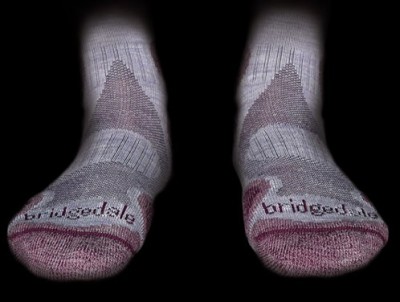
The most frequent skier gear error is poor sock choice. I see it all the time.
Poor sock choice leads to bodily pain. For a guy skiing 15 days a year — one of his annual ski trips — this is a show stopper. For those with nice bootfits and good skiers too. Some guy bought a flight here and hotel for the week, has nice gear and boots, but won’t throw down for a $20.00 pair of ski specific socks? Chooses to wear cotton athletic socks until his feet are blistered? I literally see it all the time!
There are two major flavors concerning sock choice. Synthetic and wool. Skiers should look no further than Ultra thin wool (Smartwool) or a microfiber synthetic (Bridgedale).
There is zero reason to spend a penny more on anything fancier. $60.00 ski socks??? That’s crazy.
Right from the start, I believe many shoppers are using too thick a sock. Since the ski boot liner has a finite life span (about 25-40 days), it is essential to not accelerate this process at all. In a bootfit, make sure you are using as thin a sock as possible. With rare deviations, I will have my customer use one of the two above choices.
Using a padded sock for the fit process kills the liner and can cause shear if you are not putting your boots on properly. Padded socks have their place, but can be far more limiting than you think. The additional material is usually found on the heel and shin. Sometimes, I see socks with padding under the metatarsal heads — that’s a neuroma waiting to happen! Shear in a ski boot cannot be underestimated.
The combination of Friction and Shear will shut down your vacation. A bootfit should eliminate volume in the boot enough so that shear is reduced. Adding elevation and lateral stresses in skiing overwhelm the strength of the sock material and shear/friction occurs. Water in the form of sweat acts as a lubricant and increases the potential for movement. Most ski boots are too big anyway. The evils of muscular over-compensation and repetitive microtrauma are conjoined with the too-big boot. Adding a thick sock with even a marginal amount of elevation or volume increases shear in the boot.
As I was telling a guy the other day, all problems in the boot need to be sorted out in two ways: 1) problems that require tightening up the boot, which reduces volume and the potential for shear, and 2) problems that require loosening up the boot, which add volume and reduces the even greater potential for shear.
Volume is deceptive: roomy comfort sacrifices control. The boot should be tight enough to relax the foot up against the inside of the boot, not so much that it causes cramping or creates a feeling that one should pucker the feet. The problem with a very tight boot cuff is that it causes the skier to pucker their feet, straining muscles and nerves up the kinetic chain. Socks can add to this pressure by reducing volume in your boot cuff. Ever notice how you can move your fingers by palpating your forearm? It’s the same with your ski boot cuff. Incorrect sock choice can cause the same effect by changing how your foot sits (and hopefully relaxes) on the custom insert.
I have friends (and some are ladies, too) that will wear a sock 30 days straight! I can hear them crunch when they take them off in our shop’s employee locker room.
Don’t be afraid to change them at lunch. And maybe every few days thereafter.
This article originally appeared on EpicSki.com and is republished with permission.
Image from IrishFireside on the flickr Creative Commons
 Your Privacy Choices
Your Privacy Choices
 The
The